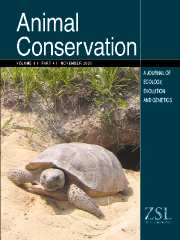Article contents
Role of human population size in raising bird and mammal threat among nations
Published online by Cambridge University Press: 04 April 2001
Abstract
It is commonly held that species loss is linked to human population size but there are surprisingly few quantitative studies that measure the strength and nature of this linkage. In a study of about 150 nations, a highly significant positive relationship (P << 0.01) was found between population size and threat levels of birds and mammals. For continental nations, log population explains 16-33% of the variation in threat level among nations. The pattern of the continental population-threat correlation indicates that per capita human impacts are initially very high and asymptotically diminish with increasing population size. No population-threat correlation was found for island nations, since human impacts are apparently so catastrophic that human population size is largely irrelevant. Surprisingly, for both islands and continents, area does not affect the level of threat after human population size is accounted for. Thus, even on continents the harmful impacts of humans, for a given population size, are evidently so profound that no amount of added area provides compensatory refugia for native species. Major regional differences in levels of threat are shown, with nations in Asia and the Middle East having generally higher proportions of threatened species than nations in Africa. The causes of these differences are only partly related to population size. Other factors not related to population size are that Asian nations tend to have much higher rates of mammal over-harvesting and Middle Eastern nations tend to have statistically lower percentages of area set aside as preserves. Threat proportions are correlated between birds and mammals among nations implying that one group may be a proxy indicator of impacts on the other. The slope of this relationship indicates that mammals suffer more losses during initial human impacts but proportions of threatened birds increase more rapidly than mammals as human impacts become more widespread.
- Type
- Research Article
- Information
- Copyright
- © 2001 The Zoological Society of London
- 201
- Cited by


